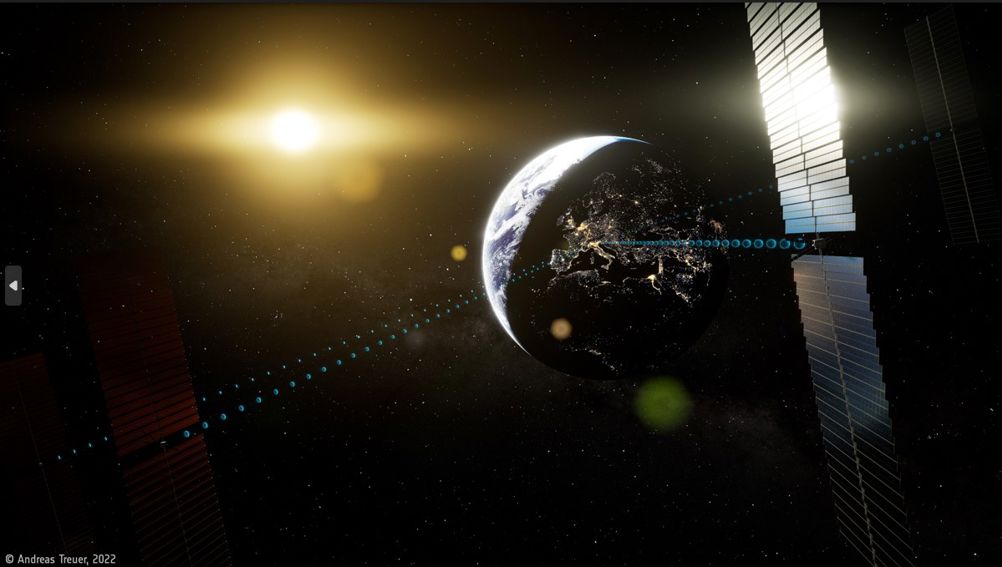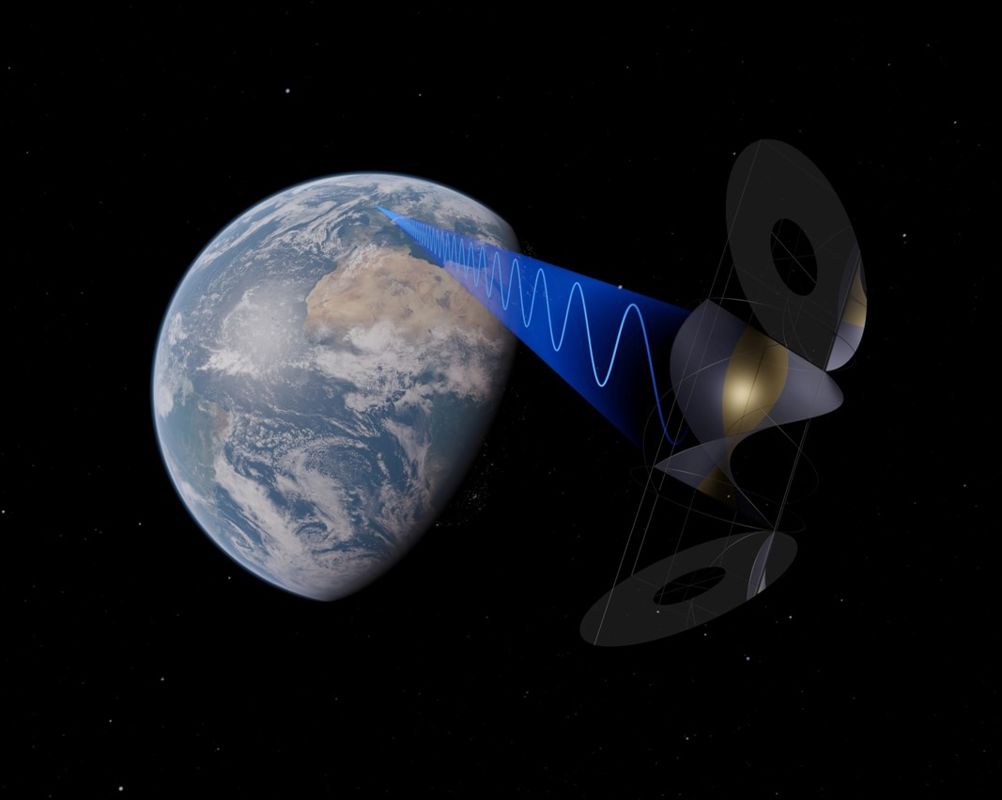As the push for a carbon free planet becomes ever more urgent, global interest in space based solar power (SBSP) - a concept that promises a limitless, uninterruptable supply of renewable energy - is gathering pace. We asked a number of researchers and engineers at the forefront of this fascinating area about the potential of the concept, progress on the key underpinning technologies, and what - in their view - the key technical challenges are to making it a reality.
Meet the experts
Dr Nicol Caplin - Exploration Scientist, ESTEC, European Space Agency (ESA)
Paul Febvre – CTO - Satellite Applications Catapult
Sam Adlen – Co-CEO Space Solar

What are the attractions and potential benefits of space based solar?
NC: The primary driver for space-based solar power (SBSP) is the pressing and immediate need to find an alternative energy source that could wean humanity from its dependency on fossil fuels. ESA’s Solaris project aims to provide Earth with a limitless, renewable energy source.
PF: Space based solar power makes it possible to rapidly and dynamically deliver power to a city anywhere within view of the space-based solar power station in response to a local surge in energy requirements at any time of day or night, irrespective of weather conditions. This can potentially circumvent the requirement for a resilient ‘national grid’, and can be used to supplement terrestrial solar-power infrastructure with a reliable additional source of energy.
SA: SBSP offers highly desirable characteristics and favourable economics, and consequently the global addressable market could see 20% of the world’s electricity or 10 Bn MWh delivered by SBSP in coming decades. The Levelised Cost of Electricity (LCoE) £26/MWh is around one third that of large scale nuclear, on a par with intermittent wind and terrestrial solar and significantly less than other baseload technologies such as nuclear fission. The compelling economics is driven by the fact the solar panels in space receive about 13 times more incident energy in space then they do on the ground for a country like the UK.
Outline the key technology elements of a space-based power station?
NC: A SBSP system uses well-established space technologies like solar panels and devices which convert electricity into radio waves in addition to arrays of transmitters for communication. For the power generation goals of Solaris (in the order of gigawatts), a massive scale-up all of these technologies is needed to create structures hundreds of metres or even kilometres long and weighing thousands of tonnes, and that is “just” the part in space. To receive and convert the solar energy, a receiving antenna of considerable magnitude, also known as a rectenna, would be required on ground before a transfer of power to the grid can occur.

SA: A typical SBSP system concept comprises a massive, kilometre scale satellite in Geostationary Earth Orbit (GEO), about 36,000 km above a point on the Earth for GW scale generation. At this altitude the Sun is visible over 99% of the time.
The satellite features large lightweight solar panels, often with a system of mirrors to reflect and concentrate sunlight onto the panels. The electricity generated by the solar panels is converted into microwave radiation and is beamed to a rectifying antenna (a ‘rectenna’) on the ground. The frequency of the microwave beam is chosen to minimise attenuation from the atmosphere, clouds or precipitation, and the maximum beam intensity is set to safe limits.
A secure pilot beam is transmitted from the ground to the satellite to allow the microwave beam to lock onto the correct target. The ground ‘rectenna’ converts the electromagnetic energy into direct current electricity which can be converted and transformed to provide power to the grid with acceptable characteristics.
Describe your involvement in the field
NC: As Research Scientist on Solaris, I coordinate the various research activities needed to answer fundamental questions; from effects of a focused beam of microwave energy on the atmospheric layers of Earth, right the way through to potential interference with other essential infrastructure. In parallel to the academic research activities, we are currently running systems studies with industrial partners. Although we are early on in our process, the concept architectures are truly beginning to take shape and we are continuously seeing a stream of exciting ideas brought to the table.
PF: At Catapult we are directly involved in two main areas: Setting up the environment for testing of in-orbit servicing and assembly capabilities and designing the mechanisms and algorithms for calibration, monitoring and secure control of the space-based power stations.
SA: Space Solar will lead the development of Space Based Solar Power (SBSP), delivering a first space solar power station in six years, commercial power in nine years and a first GW system in 12 years. The patented CASSIOPeiA (Constant Aperture Solid State Integrated Orbital Phased Array) Solar Power Satellite, from IECL (International Electric Company) around which Space Solar is focused, offers distinct and unique advantages over other international designs.
How might a space based solar power station be economically and efficiently assembled, operated and maintained?
NC: This would be the biggest thing humanity has ever put in space. SBSP therefore presents an opportunity for groundbreaking engineering through the development of a modularly designed orbiting solar farm. To do this in an economically sensible way, it requires mass production of identical components, launched on affordable rockets and pieced together in space robotically in a process known as in-orbit assembly. The same principle will apply for any maintenance needed where human crews are unlikely to be called in to tighten any bolts. Astronauts have an important place in space, but for what we are doing and how long maintenance could take, it is robots that don’t have to worry about running out of air.
PF: To provide meaningful power (2GW) delivered to a relatively small (50 sqkm) rectenna, each space-based solar power station is likely to have a mass of between 2000 and 5000 metric tonnes, which even taking into account the heavy lift capability of Space-X Starship is likely to take over 100 launches to geostationary orbit. It is likely that the most economically viable approach to assemble such a structure is for each launcher to carry multiple modules to geostationary orbit.

SA: We expect that the assembly machines will remain part of the operational system and undertake through life inspection and maintenance tasks, and then support end of life decommissioning. The fact that the satellites are comprised of many thousands of the same modules gives great redundancy. As modules fail, the system continues and those modules can just be replaced. In this operating model, the satellites can live well beyond their nominal 25 year lifetime.
When will the technology become a reality?
NC: The Solaris programme runs for 3 years. Early, sub-scale in-orbit demonstrators are slated by 2030, scaling up to a pilot plant by 2035 and the GW scale system by 2040. If this all goes to plan, we would then need a rapid deployment of the systems en masse, aiming to provide a substantial portion of the European energy mix by 2050.
PF: It is likely that it will be possible to design, develop, and deploy test infrastructure in space within 5 years, and for the technology to be ready to support a functional first generation system within 12-15 years. The biggest concerns at present are not technological, but rather are socio-political and regulatory. The first steps towards driving investment into the future systems will need to be a clear commitment to addressing the regulatory barriers that stand in the way of such viable alternative energy sources to allow us to achieve net-zero by 2050.
SA: The science is well understood and SBSP can be developed within 12 years, with the first system operational by 2035, and several systems operational by the mid-2040s. Crucially, this is in time to make a substantial difference for achieving Net Zero by 2050.




Poll: Should the UK’s railways be renationalised?
Rail passenger numbers declined from 1.27 million in 1946 to 735,000 in 1994 a fall of 42% over 49 years. In 2019 the last pre-Covid year the number...